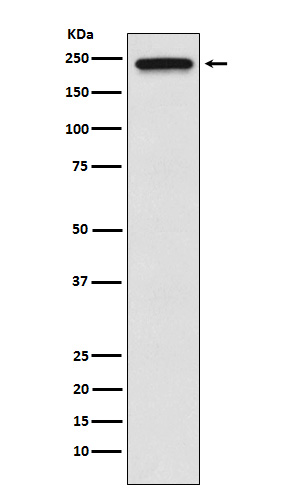TRPM7 Rabbit mAb
- SPECIFICATION
- CITATIONS
- PROTOCOLS
- BACKGROUND

Application
| WB, FC, ICC |
|---|---|
| Primary Accession | Q96QT4 |
| Reactivity | Human, Mouse, Rat |
| Host | Rabbit |
| Clonality | Monoclonal Antibody |
| Calculated MW | 212697 Da |
| Gene ID | 54822 |
|---|---|
| Other Names | TRPM7 |
| Dilution | WB~~1/500-1/1000 FC~~1:10~50 ICC~~N/A |
| Format | 10mM PBS, pH 7.4, 150mM sodium chloride, 0.05% BSA, 0.02% sodium azide and 50% glycerol. |
| Storage | Store at 4°C short term. Aliquot and store at -20°C long term. Avoid freeze/thaw cycles. |
| Name | TRPM7 |
|---|---|
| Synonyms | CHAK1, LTRPC7 {ECO:0000303|PubMed:113855 |
| Function | Bifunctional protein that combines an ion channel with an intrinsic kinase domain, enabling it to modulate cellular functions either by conducting ions through the pore or by phosphorylating downstream proteins via its kinase domain. The channel is highly permeable to divalent cations, specifically calcium (Ca2+), magnesium (Mg2+) and zinc (Zn2+) and mediates their influx (PubMed:11385574, PubMed:12887921, PubMed:15485879, PubMed:24316671, PubMed:35561741, PubMed:36027648). Controls a wide range of biological processes such as Ca2(+), Mg(2+) and Zn(2+) homeostasis, vesicular Zn(2+) release channel and intracellular Ca(2+) signaling, embryonic development, immune responses, cell motility, proliferation and differentiation (By similarity). The C-terminal alpha-kinase domain autophosphorylates cytoplasmic residues of TRPM7 (PubMed:18365021). In vivo, TRPM7 phosphorylates SMAD2, suggesting that TRPM7 kinase may play a role in activating SMAD signaling pathways. In vitro, TRPM7 kinase phosphorylates ANXA1 (annexin A1), myosin II isoforms and a variety of proteins with diverse cellular functions (PubMed:15485879, PubMed:18394644). |
| Cellular Location | Cell membrane; Multi-pass membrane protein {ECO:0000250|UniProtKB:Q923J1}. Cytoplasmic vesicle membrane {ECO:0000250|UniProtKB:Q923J1}; Multi-pass membrane protein {ECO:0000250|UniProtKB:Q923J1}. Note=Localized largely in intracellular Zn(2+)-storage vesicles. {ECO:0000250|UniProtKB:Q923J1} |

Thousands of laboratories across the world have published research that depended on the performance of antibodies from Abcepta to advance their research. Check out links to articles that cite our products in major peer-reviewed journals, organized by research category.
info@abcepta.com, and receive a free "I Love Antibodies" mug.
Provided below are standard protocols that you may find useful for product applications.
If you have used an Abcepta product and would like to share how it has performed, please click on the "Submit Review" button and provide the requested information. Our staff will examine and post your review and contact you if needed.
If you have any additional inquiries please email technical services at tech@abcepta.com.













 Foundational characteristics of cancer include proliferation, angiogenesis, migration, evasion of apoptosis, and cellular immortality. Find key markers for these cellular processes and antibodies to detect them.
Foundational characteristics of cancer include proliferation, angiogenesis, migration, evasion of apoptosis, and cellular immortality. Find key markers for these cellular processes and antibodies to detect them. The SUMOplot™ Analysis Program predicts and scores sumoylation sites in your protein. SUMOylation is a post-translational modification involved in various cellular processes, such as nuclear-cytosolic transport, transcriptional regulation, apoptosis, protein stability, response to stress, and progression through the cell cycle.
The SUMOplot™ Analysis Program predicts and scores sumoylation sites in your protein. SUMOylation is a post-translational modification involved in various cellular processes, such as nuclear-cytosolic transport, transcriptional regulation, apoptosis, protein stability, response to stress, and progression through the cell cycle. The Autophagy Receptor Motif Plotter predicts and scores autophagy receptor binding sites in your protein. Identifying proteins connected to this pathway is critical to understanding the role of autophagy in physiological as well as pathological processes such as development, differentiation, neurodegenerative diseases, stress, infection, and cancer.
The Autophagy Receptor Motif Plotter predicts and scores autophagy receptor binding sites in your protein. Identifying proteins connected to this pathway is critical to understanding the role of autophagy in physiological as well as pathological processes such as development, differentiation, neurodegenerative diseases, stress, infection, and cancer.


